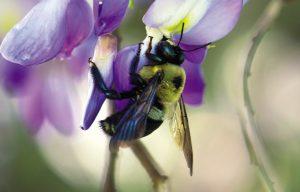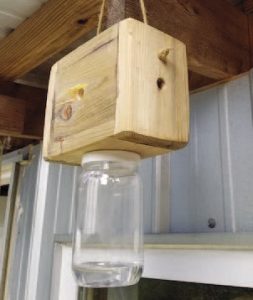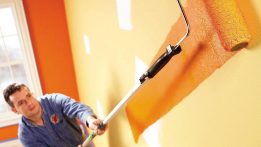 Spring and summer mark the re-emergence and familiar buzzing of Carpenter Bees. Their buzzing sound and hovering about flowers and exposed wood on houses, barns, decks, and porches signify their intent to bore nest holes and lay eggs within those wooden structures. Common myths about Carpenter Bees are they do not help pollinate our fields and they actually eat wood structures. The Good in the title is because these bees actually provide over 10% of the pollination to help our fruits and vegetables grow throughout North America. Carpenter Bees survive by eating pollen, but they also collect pollen to deposit with their eggs, which is The Bad in the title. The total damage caused by these borers is estimated at over $5,000,000,000 per year in the United States alone. Thankfully, there may be a cure.
Spring and summer mark the re-emergence and familiar buzzing of Carpenter Bees. Their buzzing sound and hovering about flowers and exposed wood on houses, barns, decks, and porches signify their intent to bore nest holes and lay eggs within those wooden structures. Common myths about Carpenter Bees are they do not help pollinate our fields and they actually eat wood structures. The Good in the title is because these bees actually provide over 10% of the pollination to help our fruits and vegetables grow throughout North America. Carpenter Bees survive by eating pollen, but they also collect pollen to deposit with their eggs, which is The Bad in the title. The total damage caused by these borers is estimated at over $5,000,000,000 per year in the United States alone. Thankfully, there may be a cure.
 Carpenter Bees (genus xylocopa) are the largest native bees in North America. The eastern part of the United States is home to the Eastern Carpenter Bee (xylocopa Virginica), which is similar in appearance to the Bumble Bee, but is distinguished by its large size, shiny black abdomen, and yellow haired thorax. The male Carpenter Bee has a white dot on its head between its eyes but has no stinger. The female does have a stinger but usually will not attack unless provoked.
Carpenter Bees (genus xylocopa) are the largest native bees in North America. The eastern part of the United States is home to the Eastern Carpenter Bee (xylocopa Virginica), which is similar in appearance to the Bumble Bee, but is distinguished by its large size, shiny black abdomen, and yellow haired thorax. The male Carpenter Bee has a white dot on its head between its eyes but has no stinger. The female does have a stinger but usually will not attack unless provoked.
 Carpenter (“borer”) Bees deposit their eggs in holes they bore out in any wood structure they come across. Wooden structures can be damaged quite extensively. Female Carpenter Bees make an initial nest hole in which they deposit several eggs and a pocket of pollen for the larvae. As the larvae develop and hatch into adults, they have the tendency to come back and expand the holes year after year. These holes can extend several feet into the wood and cause severe structural damage not to mention the staining caused by fecal deposits on the outside.
Carpenter (“borer”) Bees deposit their eggs in holes they bore out in any wood structure they come across. Wooden structures can be damaged quite extensively. Female Carpenter Bees make an initial nest hole in which they deposit several eggs and a pocket of pollen for the larvae. As the larvae develop and hatch into adults, they have the tendency to come back and expand the holes year after year. These holes can extend several feet into the wood and cause severe structural damage not to mention the staining caused by fecal deposits on the outside.
In addition, large woodpeckers, such as the Piliated Woodpecker, seeking out the larvae within the nest will do considerable damage to siding, fascia boards, posts and power poles in their pursuit of their favorite food. Power companies routinely wrap power poles to protect from damage caused by woodpeckers seeking Carpenter Bees nests.
 Husband and wife Bruce and Renée of ‘MyCarpenterBeeTraps’ say, “If you have a Carpenter Bee problem, put down the tennis racket, stop expensive pesticides, and instead ‘lock ‘EM Up.’” Over the years, many solutions have been tried—some better than others. Their ‘patent pending’ product may be The Cure. It has merit and comes with a 100% guarantee to work.
Husband and wife Bruce and Renée of ‘MyCarpenterBeeTraps’ say, “If you have a Carpenter Bee problem, put down the tennis racket, stop expensive pesticides, and instead ‘lock ‘EM Up.’” Over the years, many solutions have been tried—some better than others. Their ‘patent pending’ product may be The Cure. It has merit and comes with a 100% guarantee to work.
For more information about Carpenter Bees, call a professional. Do not believe all you read online. Help is just a call away at 850-933-1810 or MyCarpenterBeeTraps.com / MyBeeTraps.com. ![]()
B. Millar




